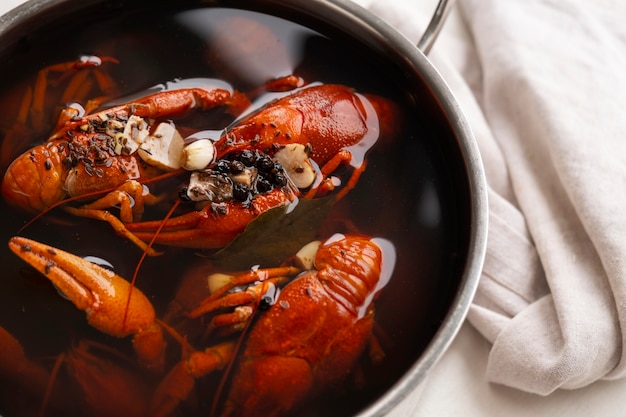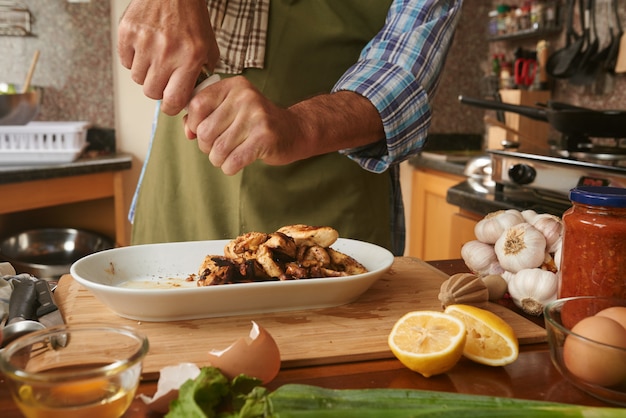Ah, the lobster boil. It’s a classic for a reason, isn't it? That irresistible aroma of fresh seafood, the communal feast, and the good company – it's a recipe for a truly unforgettable experience. But let's be honest, mastering the art of the lobster boil can feel a bit daunting. You've got the lobsters, the pot, and a vague idea of what you're supposed to do. But worry not, my friend, for I'm here to guide you, step by step, through the ins and outs of crafting a lobster boil that'll have your guests raving.
(Part 1) Choosing Your Lobster

The Star of the Show: Finding the Right Lobster
The lobster, the main attraction, the star of the show – it all comes down to finding the perfect specimen. You don't want to end up with a scrawny, rubbery lobster that's more trouble than it's worth. I’m a big fan of supporting local fishermen and markets, as the quality is often unbeatable. However, if you’re struggling to find what you need, those big supermarkets can be lifesavers. But remember, size matters when it comes to lobsters! Aim for a hefty lobster, around 1.5 lbs (700g) or more, to ensure everyone gets a satisfying share of that sweet, juicy meat.
Spotting a Freshie: Identifying the perfect lobster
"How do I tell if a lobster is fresh?" You're asking the right question. Look for a lobster with a vibrant, deep-red colour. Its shell should be hard, and its antennae should be lively, twitching with energy. If the lobster is sluggish or dull in colour, it’s probably not the freshest. Another telltale sign is the lobster's tail. If it curls tightly under its body, it's a sign of a fresh, healthy lobster. It means that lobster's ready to party!
(Part 2) The All-Important Boil

Getting the Pot Ready: The Essential Equipment
Alright, your lobsters are chosen. Now, let’s get this party started! The key to a successful lobster boil is a big, sturdy pot. Look for one with a wide base and sturdy handles, capable of holding all those lobsters and the delicious additions you'll be throwing in. A classic stockpot works like a charm. You’ll also need a good-sized burner or grill, one that can handle the weight of the pot and generate enough heat to bring the water to a rolling boil.
The Boil Formula: Getting the Flavour Right
Now, let’s talk about the heart of the matter – the boil mix. This is where you can truly add your own flair, creating a unique flavour profile that reflects your personal taste. While I'm all about keeping things simple, a classic boil mix usually includes:
- Salt: This is essential, my friend. You need enough salt to bring out the lobster’s natural sweetness. Think of it as amplifying its inherent flavour.
- Water: You need enough water to cover the lobsters by at least a couple of inches. This ensures they cook evenly and prevents them from sticking to the bottom of the pot.
- Lemon wedges: These add a lovely acidity and refreshing zing. They cut through the richness of the lobster and add a delightful touch of brightness.
- Onions: I use a couple of whole onions, quartered. They add a hint of sweetness and depth of flavour, creating a richer broth.
- Garlic: I go for 4-6 cloves, roughly chopped. Let's face it, you can never have too much garlic in a lobster boil. It adds that bold, punchy flavour that's simply irresistible.
- Celery: Celery adds a touch of earthiness, balancing the sweetness of the other ingredients. I usually chuck in a couple of stalks, chopped into pieces.
- Black peppercorns: A little black pepper goes a long way. I add about 1 tablespoon to give the boil a subtle spiciness.
- Bay leaves: Bay leaves infuse the boil with a wonderful aroma. I use 2-3 bay leaves for a subtle but distinct flavour.
- old bay seasoning: This is a must-have for a traditional lobster boil. It's a blend of herbs and spices that adds a unique, complex flavour, elevating the boil to a whole new level.
Remember, these are just suggestions. Feel free to experiment and add your own favourite herbs and spices. Think of it like your personal signature. But remember, a good lobster boil should be a symphony of flavours, not a chaotic clash!
Timing is Everything: How Long to Boil
Everything's in the pot, the water's boiling, and you’re about to drop those beautiful lobsters in. Now, how long do you boil them? The answer, my friend, depends on the size of your lobsters. I usually aim for 10-12 minutes for a 1.5 lb lobster. For larger lobsters, you might need to add a couple of minutes to ensure they’re cooked through. But don't just trust your intuition. A meat thermometer is your best friend here. Make sure the internal temperature has reached 140°F (60°C). Another good trick is to test the meat with a fork or skewer. If it pulls easily from the shell, it's done.
(Part 3) The Feast Begins

Serving Up a Delight: The Art of Presentation
Your lobsters are cooked to perfection, the aroma is intoxicating, and it’s time to bring the feast to the table. A lobster boil isn't just about the food, it’s about the experience. To set the scene, cover your table with newspapers or plastic sheeting to keep the mess under control. Not only is it practical, but it also adds a fun, rustic feel. Use a large platter or a couple of smaller ones to display your lobsters, making them the centrepiece of the table. Remember to have plenty of napkins and wet wipes on hand – let’s face it, lobster can get a bit messy.
The Side Show: Accompanying Delights
A lobster boil simply isn't complete without some delectable side dishes. Now, I'm a firm believer in letting the lobster shine, but if you want to add some extra flavour and variety to the feast, here are a few ideas:
- corn on the cob: A classic for a reason. The sweetness of the corn perfectly complements the lobster's richness, creating a delightful balance of flavours.
- Red Potatoes: A good old-fashioned boiled potato is a comforting and filling side dish for a lobster boil. They’re simple to prepare and absorb the flavour of the boil mix, adding a delicious dimension to the feast.
- Garlic Bread: This is a delicious and easy way to soak up all those delicious juices from the lobster boil. The buttery garlic flavour pairs perfectly with the lobster and adds a touch of indulgence.
- Coleslaw: A refreshing side dish to cut through the richness of the lobster. The crisp, tangy flavours of the coleslaw provide a palate cleanser, making each bite of lobster even more enjoyable.
- fruit salad: A light and refreshing dessert for a hot summer day. The sweetness of the fruit provides a delightful contrast to the savoury flavours of the lobster boil.
(Part 4) Cracking Open the Treasure
The Art of Lobster Deconstruction: Cracking Techniques
Your table is set, the lobsters are steaming, and your guests are starting to get hungry. It's time to crack open those lobsters! Now, this is where the fun really begins. It might seem intimidating at first, but trust me, it's not as hard as it looks. The first step is to remove the rubber bands that hold the claws together. Now, use a lobster cracker or a sturdy nutcracker to crack open the claws. You'll find the sweetest, most succulent meat inside.
Mastering the Claw: Extracting the Meat
Once the claws are cracked, you'll find that the meat is starting to come loose. Use a lobster pick to gently pry out the meat. If you're feeling adventurous, try using your fingers to extract the meat from the claws. It's a bit messy, but it’s definitely the most satisfying way to do it. You'll feel like a seasoned lobster connoisseur!
The Tail of the Story: Extracting the Tail Meat
Now, let’s move on to the tail. The tail is the biggest chunk of meat in the lobster, so you’re in for a treat. First, twist the tail off the body. Then, use a knife to cut along the underside of the tail, from the bottom to the top. This will help you easily remove the tail meat. Once the tail meat is out, use your fingers to pick out any remaining bits. The tail meat is usually the sweetest and most succulent part of the lobster, so savour every bite.
(Part 5) The Lobster Boil Experience
The Unforgettable Atmosphere: Creating a Memorable Event
Look, a lobster boil is about so much more than just the food. It’s about creating a memorable experience for your guests. It's about the laughter, the stories, the shared joy of indulging in a delicious feast. To set the mood, get some good music going – a playlist of your favourite tunes will instantly enhance the atmosphere. Decorate your outdoor space with string lights or lanterns to create a warm, inviting ambiance. Remember, the most important ingredient for a successful lobster boil is good company.
The Unwritten Rules: Lobster Boil Etiquette
You might be thinking, “Lobster etiquette? Is that a thing?” While it doesn’t have to be formal, there are a few unwritten rules that can make the experience more enjoyable for everyone. First and foremost, be patient. It takes a little time to crack open a lobster and get to the good stuff. So, relax, enjoy the company, and savor each bite. Secondly, embrace the mess. A lobster boil is about letting loose and enjoying the moment. Don't worry about a few stray bits of shell or a little bit of sauce on your fingers. Finally, share the experience. Pass the lobster crackers, offer a helping hand with the claws, and share those delicious stories about your favourite lobster adventures.
A Feast for the Senses: Enjoying the Experience
A lobster boil is a feast for all the senses. It’s about the aroma of the boiling water, the sound of the lobsters being dropped into the pot, the laughter of your friends and family as they crack open their lobsters. It's about the messy fingers and the happy faces. It’s about creating memories that will last a lifetime.
(Part 6) Beyond the Boil: Leftover Lobster Magic
Turning Leftovers into Treats: lobster recipes
You've had your feast, the last lobster has been devoured, but you've got a mountain of leftover lobster meat. Don't despair, my friend! You can turn those leftovers into a whole new range of delicious dishes. Here are a few ideas to get your creative juices flowing:
- Lobster Salad: Combine leftover lobster meat with mayonnaise, celery, onion, and a pinch of salt and pepper. Serve it on a bed of lettuce or in a sandwich for a light and refreshing lunch.
- lobster mac and cheese: Toss leftover lobster meat with your favourite macaroni and cheese recipe for a decadent treat. You can even add a touch of cream and some fresh herbs for an extra layer of flavour.
- Lobster Risotto: Sauté some onions and garlic, add leftover lobster meat, and then slowly incorporate risotto rice. You’ll end up with a creamy, flavorful risotto that's packed with flavour.
- lobster bisque: Blend leftover lobster meat with a base of cream, milk, and vegetables. You’ll have a thick and creamy soup that’s perfect for a cosy dinner.
- Lobster Pizza: Combine leftover lobster meat with a tomato sauce base and mozzarella cheese for a delicious and unique pizza. It's a twist on the classic pepperoni pizza that's sure to impress.
(Part 7) Lobster Boil: A Global Affair
From Coast to Coast: Lobster Boil Traditions
You know, the lobster boil isn't just a British thing. It’s a global phenomenon, with different regions and cultures adding their own unique twists. In the United States, the traditional New England lobster boil is a staple of summer gatherings. They often include corn on the cob, red potatoes, and a generous helping of Old Bay seasoning. In France, a lobster boil is often referred to as a "bouillabaisse" and typically includes a variety of seafood, including mussels, clams, and fish.
Beyond the Boil: Other Lobster Delights
While the lobster boil is the ultimate way to celebrate this delicious crustacean, there are other ways to enjoy it. From lobster rolls to lobster bisque, there's a lobster dish out there for every taste bud. And let's not forget about the lobster roll, a classic New England treat that's sure to satisfy any seafood lover.
(Part 8) The Lobster Boil Essentials
So, you're ready to throw your own lobster boil. You’ve got the knowledge, the recipe, and the excitement. But before you get started, you need to make sure you've got all the essentials. Here's a checklist to ensure you're fully equipped for a fantastic feast:
| Essentials | Details |
|---|---|
| Lobsters | Choose lobsters that are lively and fresh, with a vibrant colour and hard shell. |
| Large Pot | You need a pot that can hold all the lobsters and the other ingredients. |
| Burner or Grill | You’ll need a burner or grill that can handle the weight of the pot and the heat. |
| Lobster Crackers | These are essential for cracking open the lobster claws. |
| Lobster Picks | These will help you extract the meat from the claws and tail. |
| Napkins and Wet Wipes | Lobster can get messy, so it’s always a good idea to have plenty on hand. |
| Side Dishes | Prepare some tasty side dishes to accompany your lobster feast. |
| Beverages | Don't forget the drinks! Offer a variety of beverages to suit everyone's taste. |
| Music | Set the mood with some good music. |
| Decorations | Add some decorations to create a festive atmosphere. |
| Good Company | The most important ingredient for a successful lobster boil is good company. |
FAQs
1. What if I can't find fresh lobsters?
Don't worry, you can still have a delicious lobster boil! Frozen lobsters are a good alternative. Just make sure they're high quality and stored properly. When you're ready to boil them, defrost them in the refrigerator overnight. You'll be surprised how close you can get to the taste of fresh lobsters.
2. Can I boil other seafood with the lobsters?
Absolutely! You can add other seafood like mussels, clams, or even shrimp to your lobster boil. Just make sure to adjust the cooking time accordingly. Mussels and clams cook much faster than lobsters, so add them towards the end of the boil. Shrimp, on the other hand, can be added with the lobsters. The result is a seafood symphony in a pot!
3. What are some other ways to cook lobster?
Besides boiling, you can also bake, grill, or steam lobster. Each method will yield a slightly different flavour and texture. Baking results in a tender, succulent lobster, while grilling gives it a smoky, charred flavour. Steaming, on the other hand, preserves the lobster's natural sweetness. Experiment and see which method you prefer!
4. How do I know if a lobster is cooked properly?
A properly cooked lobster will have a bright red colour and the meat should be firm and white. You can also use a meat thermometer to check the internal temperature. The lobster is cooked through when the internal temperature reaches 140°F (60°C). If you're unsure, it's always better to err on the side of caution and cook it for a little longer.
5. What are some tips for storing leftover lobster?
Leftover lobster meat can be stored in the refrigerator for up to 3 days. To keep it moist, store it in an airtight container with a small amount of broth or melted butter. You can also freeze leftover lobster meat for up to 3 months. Just remember to thaw it in the refrigerator before using.
So, there you have it, my guide to hosting the ultimate lobster boil. Get ready for a feast that's packed with flavour, laughter, and memories that will last a lifetime. Happy boiling!
Everyone is watching

Corn on the Cob: The Ultimate Guide to Perfectly Cooked Ears
Healthy MealsAh, corn on the cob. Just the name evokes images of sunny days, barbecues, and that sweet, juicy flavour that ...

Scallops: The Ultimate Guide to Perfect Cooking
Healthy MealsAh, scallops. Those delicate, sweet, and utterly delicious morsels of the sea. They hold a special place in my...

Spaghetti Squash: The Ultimate Guide to Cooking and Serving
Healthy MealsRemember that time you saw spaghetti squash at the supermarket, looking all bumpy and strange, and thought, "W...

Salmon Cooking Times: Perfect Guide for Every Recipe
Healthy MealsLet me tell you, cooking salmon is an art form. It's all about getting that perfect balance: juicy and tender,...

Ham Cooking Time: How Long to Bake, Smoke, or Boil a Delicious Ham
Healthy MealsAh, ham. It's a classic, isn't it? A real crowd-pleaser, especially around holidays. And when done right, it'...
